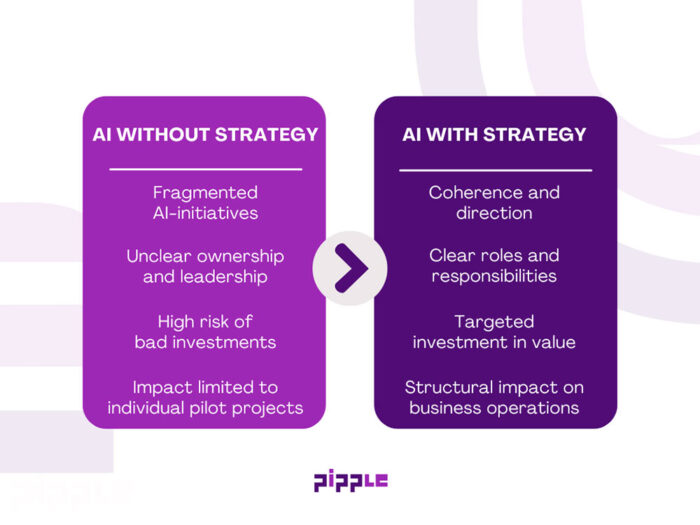Nevertheless, many organisations are struggling with the question: how can we truly derive value from AI? According to the Gartner Hype Cycle, generative AI has just passed the “Peak of Inflated Expectations” and is descending into the “Trough of Disillusionment” — a phase in which hype gives way to reality. The technology is powerful, but expectations have been overestimated in the short term. That does not mean that AI is failing. On the contrary: it will become a permanent and decisive part of strategic concerns, organisational design and business models. The challenge is to make the right choices now — with direction, structure and strategic leadership.
Why AI without strategy does not work
AI is not a product that you can purchase or order. It is a system technology that has a profound impact on processes, roles and decision-making. Moreover, implementing AI is not a one-off exercise. It is a continuous process that will remain an integral part of your strategic decision-making, organisational development and business model. It requires a clear course of action, well-supported choices and an organisation that is ready to learn, change and grow.
Without a clear course, initiatives remain fragmented, ownership remains unclear, and there is a high risk of misinvestment. The result: pilots that have little real impact.
A well-thought-out AI strategy provides coherence and direction, clear roles, and investment in value. In this way, AI becomes not a series of isolated experiments, but a structural driver of business operations.
Pioneering is not the problem – but without direction, you will run aground
Developing Proof of Concepts (PoCs) is an excellent way to discover what works and what doesn’t. In a rapidly changing world, PoCs offer valuable insights and help organisations to experiment and learn. They make technology tangible and stimulate innovation.
Yet many organisations make the mistake of thinking they are ready for AI, even though fundamental conditions are lacking. Without a broader vision and strategy, you run the risk of getting stuck in the experimental phase. You will not build sustainable value and miss the opportunity to structurally embed AI in your business operations. A strategic approach ensures that experiments contribute to a larger whole, with clear goals, priorities and measurable results.
During the phased rollout, the back-office employees would work with the AI assistant, training the application as they went.
Only when the assistant could answer almost every question perfectly would Fhris release it to end users.
The DELTA model as a compass
When determining the right strategy for an organisation, it is essential to know where you stand. At Pipple, we use Tom Davenport’s DELTA model as a tool to assess an organisation’s data maturity.
The model looks at five pillars:
- Data – Is the data available, reliable and usable?
- Enterprise – Is there organisation-wide support and integration?
- Leadership – Is leadership involved and informed?
- Targets – Are there clear goals and priorities?
- Analysts – Are the right people and skills in place?
The model is not a solution in itself, but a mirror. It shows where you stand and where you can grow. It is crucial that all five pillars are in balance. If one pillar lags behind — for example, if there is data but no leadership or clear goals — it becomes difficult to successfully implement and scale AI. Your organisation’s data maturity determines which strategy is feasible and effective.
To assess our AI readiness, they then, together with my steering group, mapped out our internal AI status along the pillars of the DELTA model.
This exercise highlighted what we were already doing well and revealed our biggest hindrance: our own leadership. It sparked valuable, reflective conversations.
Pitfalls and accelerators: what determines success?
In practice, we see that the gap between successful and failed AI projects can often be traced back to a few patterns.
Common pitfalls:
- Technically driven projects that neglect culture;
- Thinking that AI is a product you can buy;
- Overestimating data quality and availability;
- No clear definition of ROI;
- Building without ensuring how the solution will fit into the process.
Accelerators that do lead to success:
- Vision and leadership from management;
- Collaboration with strong partners and ecosystems;
- Scalable infrastructure and tooling;
- A robust data foundation and clear governance;
- A concrete AI image linked to strategic goals.
These insights underline that AI is not a technical challenge, but a strategic and organisational transformation. It requires an integrated approach that brings together technology, people and organisation. We notice that more and more companies are achieving this, which is very exciting to see! This creates a kind of flywheel of successes that generates energy, with new initiatives building on previous solutions. Then, you notice that things start to accelerate.
That’s why we encouraged a department to experiment.
It went so well that more and more colleagues realized the value of data in improvement efforts. And also how enjoyable it is; with visible results, improvement becomes a sport.
AI requires strategy, leadership and agility
Successful organisations combine agility with strategic leadership. They operate according to the principle: fail fast, learn fast, improve fast. Not to experiment recklessly, but to test quickly, learn from outcomes and make targeted improvements.
This cycle helps organisations to:
- discover more quickly what works in their context;
- limit risks by starting small;
- and continuously improve based on feedback and insights.
Frameworks such as Lean Startup and Agile Development support this principle. They encourage iterative working, where you deliver value, collect feedback and make adjustments in short sprints. But here too, the same applies: without strategic direction, it remains limited to short-term improvements.
From shots in the dark to sustainable value
AI is not a project, but a transformation or perhaps even a revolution. The technology is here. The question is: is your organisation ready for it?
Do you want to avoid getting stuck in experiments, making the wrong choices or delaying unnecessarily? Start building a strategy today that embeds AI in your organisation. Ensure balance across all pillars of the DELTA model. Work iteratively, learn quickly and improve in a targeted manner. And above all: build on what already exists.
The future is with AI. Make sure your organisation moves with it — strategically, smartly and with impact.



